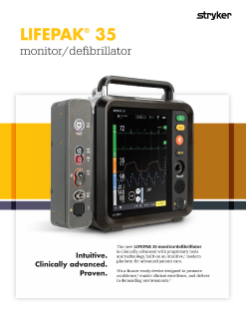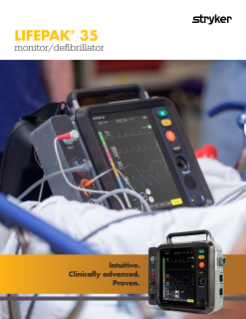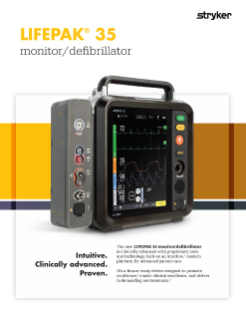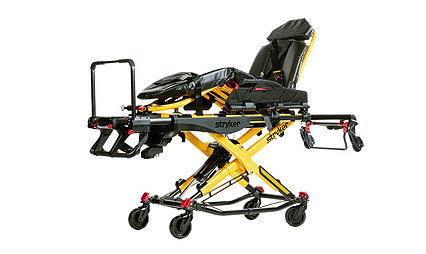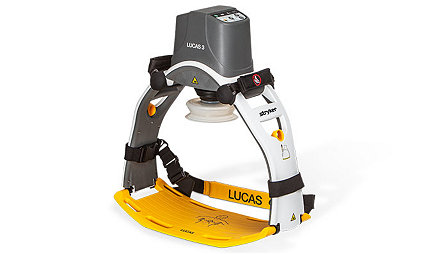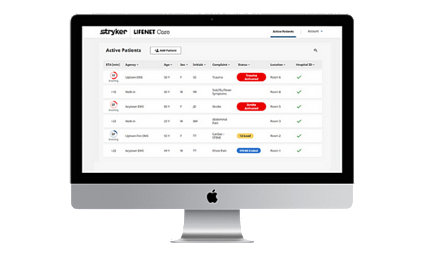Built on a legacy of trust. Ready for the future.
The LIFEPAK 35 is a future-ready device designed to promote confident cardiac care,2 enable clinical excellence and deliver in demanding environments.3
Intuitive
LIFEPAK 35’s large, easy-to-use touchscreen1 and advanced clinical decision support tools provide a customizable clinical experience that helps reduce cognitive burden.1
Clinically advanced
When every second matters, you need patient care that moves as fast as you do. With advanced connected capabilities providing insights and guidance, LIFEPAK 35 is reliably3 on your side – when time is not.
Proven
Built on a legacy of life-saving products and reimagined for today’s modern healthcare professional, the LIFEPAK 35 platform carries a foundation of trust and toughness that will advance patient care.
The monitor/defibrillator that's advancing care for both EMS and hospitals
Working in partnership with customers like you, we’ve created a slim, lightweight and ergonomically designed device to help give you more control during critical events. Whether it be on a crash cart or responding to a crashed car, our newest emergency response monitor/defibrillator balances advanced clinical technologies and ease-of-use in a device that’s tough enough to deliver in demanding environments.3

The big, tough touchscreen
- High-definition, 10.4" customizable display
- Durable, chemically reinforced glass3
- Double-glove friendly3
- Designed to withstand direct impact and drops3

Clinically advanced therapy tools
- cprINSIGHT analysis technology helps improve CPR performance by reducing pauses** during chest compressions4
- Live view 12/15-lead with STJ Insight provides a graphical representation of the ECG to help diagnose myocardial injury2
- Pediatric AED mode helps treat patients with escalating biphasic energy from 1J to 360J3,5

LIFEPAK TOUGH
- IP55 rating3 protects against dust and water
- Chemically strengthened impact-tested glass3
- FLEX lithium-ion dual battery system provides nine hours of monitoring6
- Tested to withstand severe impacts and extreme vibration3
A monitor/defibrillator built for your needs
From the roadside to the emergency room, our focus is on empowering you with the support you need to provide rapid, high-quality care under pressure.
The fully featured monitor/defibrillator with paper and two batteries installed weighs 15.75 lb (7.14 kg)
Height: 14 inches (35.5 cm)
Width: 13.8 inches (34.9 cm)
Depth: 4.9 inches (12.4 cm)
The LIFEPAK 35 monitor/defibrillator memory has a total capacity of 50 patient records with a 12-hour duration for each record.
The warranty is one year for EMS and five years for hospital use. The expected life is eight years.
A typical charge time for one or two fully depleted LIFEPAK 35 batteries is five hours when using either the battery charger or defibrillator.
Interested in learning more? Contact an expert.
Have feedback about Stryker’s products and services? Visit our product experience page to connect with us.
M0000014366 REV AA
* Based on participants surveyed.
** Pre-shock pauses were drastically reduced to an average of 8 seconds vs. an average of 22 seconds with the conventional AED. CCF with cprINSIGHT was 86 percent vs. 80 percent in the conventional AED group.
References:
1. Data on file, Stryker HFVR 3338373.
2. Data on file, Stryker OI 3337705.
3. Data on file, Stryker SHVR 3338410.
4. de Graaf C, Beesems SG, Oud S, et al., Analyzing the heart rhythm during chest compressions: Performance and clinical value of a new AED algorithm. Resuscitation. May 2021;162:320-28.
5. Data on file, Stryker UND-3331509 section 6.5.
6. Data on file, Stryker 3352191 Rev A.
EC-L35-SYK-1049051_REV-0_en_us










